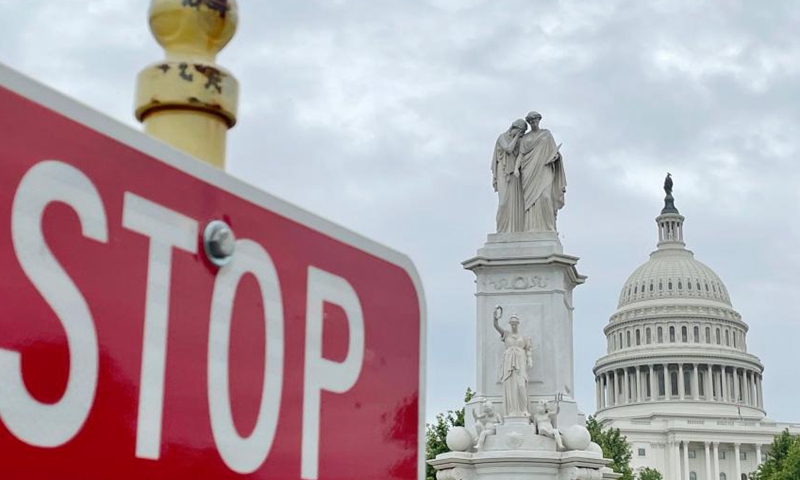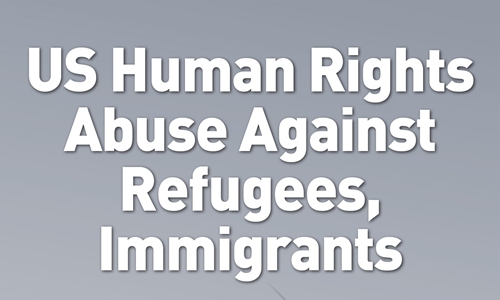
The U.S. Capitol building sits in the background of a traffic sign in Washington, D.C., the U.S., May 28, 2021.(Photo: Xinhua)
The use of child labor is not simply a violation of humanity and human rights but even a regression of human civilization and progress. In 1999, all 187 member states of the International Labour Organization (ILO) have ratified the ILO Convention on the Worst Forms of Child Labour (No.182), including the US. Since then, eliminating the worst forms of child labor has been an international obligation, yet the US has taken a backward step in terms of child labor rights in recent years. Currently, the US is rife with illegal child labor in multiple industries, forcing children into the worst forms of labor that compromises their health, safety and morals. The new report released by the US Economic Policy Institute in March showed that at least 10 states have introduced or passed laws rolling back child labor protections in the past two years. The self-proclaimed "equality" and "human rights" of the US stand in stark contrast to the brutal exploitation of child labor and violation of children's rights in reality.
Exploitation of child labor is the original sin and a modern evil of the US
The US has a dark history concerning the brutal exploitation of child labor, which is another original sin in American history. In 1791, Alexander Hamilton, as Secretary of the Treasury, noted in a report on manufacturing that children "who would otherwise be idle" could become a source of cheap labor. The 1900 US Census revealed that approximately 1.75 million employed children aged 10-15 were employed. In 1916, the US Congress passed the Keating-Owen Act, the first national protection for child labor in history. However, it was unfortunately overturned by the US Federal Supreme Court in 1918. After years of efforts, it was not until 1938, with the enactment of the Fair Labor Standards Act, that a standard of protection for child labor was established in the US.
Although child labor publicly disappeared as a result of the Act, it simply became an "invisible" problem. Since the Act does not prohibit children from working, but only ensure that the work of young people is safe and does not jeopardize their health and well-being, it provides a veneer of legalization with exemptions for child labor. The Act also states that children under 14 may not be employed in non-agricultural occupations. Thus, hundreds of thousands of US children still work on farms, and many more die in agricultural accidents than in any other industry, yet the law denies protection and remedies for children against the violations of international labor standards such as "health hazards," "hazardous working conditions" and "employment of underage children."
In recent years, the illegal employment of child labor in the US is even worsening. The US government, without effective response, rather gives the green light. At the end of 2021, Wisconsin was the first state to approve a bill that would expand the permissible work hours a minor under 16 to not after 11:00 p.m. Other states have followed suit. It is obvious that in the US, the institutional exploitation of minors, from past to present, has always been unscrupulous in its efforts to conceal and distort the truth. By technically creating loopholes in law and clearing the way for capital's profit-seeking behavior, the sinful practice of oppressing and exploiting child labor is allowed publicly.
Child labor exposes the institutional deficiencies of the US
The institutional disregard for child labor rights and the connivance of child labor reflects typical and serious structural defects of the American political and social system. Racism, immigrant children and forced labor are all the labels of modern child labor in the US. These problems accumulated over the years can't be resolved overnight.
The surge in illegal child labor is also the result of the US immigration policy. Since 2021, the Biden administration detained tens of thousands of asylum-seeking children, yet then they were placed with sponsors and have to accept forced work to survive. For sponsors, it is becoming a business. In February 2023, the New York Times exposed the illegal employment of migrant children in dangerous jobs across the US, including slaughterhouses, construction sites and car factories. Migrant children, who are suffering from cruel exploitation as a "shadow work force," are deprived of dignity, hope and a future.
US legislation and the judiciary, on the other hand, acted as connivers and bystanders. When the Fair Labor Standards Act of 1938 was introduced, the majority of the agricultural workers in the Southern states of the US were African Americans. Therefore, the Act's exemptions from child labor protections in agriculture had latent racist roots, highlighting that the exploitation of child labor forms part of systemic racism in the US. Rebecca Dixon, executive director of the National Employment Law Project, noted that the Act's exclusion of whole categories of workers from vital protections is a way to "preserve a system where employers could profit off of racist exploitation."
Not only has the US long connived at the exploitation of migrant child labor, but it has also recklessly relaxed legislative protections for child labor. The New York Times reported in February that in the past decade, US federal prosecutors had brought only about 30 cases involving forced labor of unaccompanied minors. A report released by the US' Economic Policy Institute in March revealed that states across the country are attempting to weaken child labor protections and that "children of families in poverty, and especially Black, brown, and immigrant youth, stand to suffer the most harm from such changes."
For example, Arkansas this year passed new legislation that eliminates requirements of work permission from the parent or guardian for children under 16. This blatantly opens the back door for businesses to hire migrant children separated from their families and legally exculpate child labor agents.
The US is a bad example of child and labor rights violations
In the US, a large number of children, especially those from minority ethnic groups, are more susceptible to economic exploitation, loss of educational opportunities, and an unhappy childhood, leading to further entrenchment in the depths of society. The chronic illness of racial discrimination, apathy toward immigrant welfare, and intentional tolerance of corporate responsibility not only revives the historical legacy of exploiting child labor in the 19th century but also is full of lies and self-deception in addressing the increasingly worsening problem of child labor. This has led to a deeper entrenchment in the violation of labor rights and the encroachment of children's rights.
The US is a laggard in protecting children from exploitation and forced labor. As the only UN member state that has not ratified the Convention on the Rights of the Child, the US has repeatedly been condemned by UN human rights agencies for its backwardness in protecting children's rights. At the same time, as a signatory to the Worst Forms of Child Labour Convention, the US has not actively fulfilled its international obligations to protect child labor. In response, the Committee of Experts on the Application of Conventions and Recommendations of the ILO has repeatedly urged the US to take measures to strengthen its oversight of child labor in agriculture. It is ironic that the US, on the one hand, points fingers at other countries and criticizes them, refusing to import goods with "child labor" and "forced labor" from other countries, while on the other hand, it consumes and enjoys the products of its own child labor and forced labor. This once again incisively and vividly reflects the hypocritical nature of the US "double standards human rights."
The increasingly worsening problem of child labor fully exposes the structural defects of the US system and the persistent malaise of systematic human rights violations. When it comes to protecting children's rights and eliminating child labor, the US is a negative example.
The author is an associate research fellow at the Human Rights Research Center of the Chinese Academy of Social Sciences. opinion@globaltimes.com.cn

